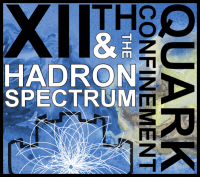Speaker
Description
ALICE is the only LHC experiment specifically devoted to the study of ultra-relativistic heavy ion collisions. Its main goal is to identify and study a new state of matter, le Quark Gluon Plasma (QGP), where quarks and gluons are deconfined, which might have existed during the first instants of the Universe. One of the most powerful signatures for QGP study is the suppression, within this hot and deconfined medium, of heavy resonances as J/psi et Upsilon. These resonances are measured in ALICE by their di-muon decay thanks to a forward spectrometer.
The muon spectrometer performances are constrained by the presence of a thick absorber, meant to stop most of the hadrons (essentially pions and kaons) before their muonic decay, thus reducing the large noise generated by their decay products. However, the presence of this absorber limits the precision of the measurement of interesting muon properties because of energy loss and multiscattering effects. This implies some limitations on the broadness of the physics results that are actually accessible. For example, only the inclusive production of J/psi can be studied and there is no room to distinguish the J/psi coming from the decay of B mesons. In order to improve the present performances of the di-muon spectrometer and thus enlarge the set of observables that ALICE can measure, a major upgrade project, called Muon Forward Tracker (MFT), is under development. The MFT will consist in a telescope of silicon-pixel detectors placed in front of the absorber, which will allow precise backtracking and vertexing from the present spectrometer. This will largely improve the energy resolution in reconstructing the heavy resonances.
The MFT is based on CMOS technology silicon pixels, assembled in Hybrid Integrated Circuits (HIC) that will equip 5 concentric disks around the beam pipe. The main detection element of these circuits is the ALPIDE chip, developed in collaboration with the ALICE-ITS detector. The chip qualification and performance studies are in their final phase before proceeding to the full production of the finalized chip. In parallel, a study and characterization campaign of the HIC, consisting of several chips connected to the final readout system developed for the MFT, is presently ongoing. This fundamental step of the project will lead to the full qualification of the base element of the MFT detector, allowing the start of the production of some 500 circuits that will equip the MFT.
In this talk, we will present the physics goal of the MFT detector and a detailed status of the R&D activities that will lead to the construction of this new detector, fundamental for the upgrade of the muon program within the ALICE collaboration.




